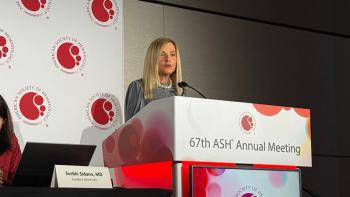
Maintenance Olaparib Aids PFS in BRCA-Mutated Metastatic Pancreatic Cancer, but Not OS
Patients with advanced pancreatic cancer linked to germline genetic mutations did not see their disease worsen for an additional 3.6 months when treated with olaparib, but an early interim analysis did not show a statistically significant difference in overall survival (OS), according to study results presented Sunday at the American Society of Clinical Oncology Annual Meeting 2019.
Patients with advanced pancreatic cancer linked to germline genetic mutations did not see their disease worsen for an additional 3.6 months when treated with olaparib, but an early interim analysis did not show a statistically significant difference in overall survival (OS), according to study results presented Sunday at the American Society of Clinical Oncology Annual Meeting 2019.
The results of the subset of patients with germline mutations in the BRCA1 and BRCA2 genes were also published Sunday in the New England Journal of Medicine.
Pancreatic cancer affects nearly 57,000 Americans annually; once it spreads, fewer than 10% of patients are alive 5 years after initial diagnosis. About 4% to 7% of patients with pancreatic cancer have a germline BRCA mutation.
The poly (ADP-ribose) polymerase (PARP) inhibitor olaparib (Lynparza) is sold by Astra Zeneca and Merck (Astra Zeneca, and a grant from the National Institutes of Health, funded the study).
The phase 3 study, called POLO (Pancreas Cancer Olaparib Ongoing), included 154 patients; 92 received olaparib at 300 mg twice a day, and 62 received placebo. The 154 patients had confirmed BRCA1/2 mutations via use of the BRACAnalysis CDx companion diagnostic from Myriad Genetics. It is currently the only FDA-approved test to find germline BRCA1/2 mutations.
To be eligible for the randomized controlled trial, the patients had received at least 16 weeks of continuous first-line platinum-based chemotherapy, with no evidence of disease progression.
The primary endpoint of the study, median progression-free survival, was significantly longer in the olaparib group than in the placebo group (7.4 months vs 3.8 months; hazard ratio [HR] for disease progression or death, 0.53; 95% CI, 0.35-0.82; P = .004).
At 24 months, 22% of the patients in the treatment group had not seen the disease progress, compared with 9.6% of the placebo group.
Given the deadly nature of advanced pancreatic cancer, the fact that maintenance olaparib could stop progression for a few months for this group of patients “is really quite remarkable,” said Johnathan M. Lancaster, MD, PhD, the chief medical officer for Myriad Genetics, maker of the BRACAnalysis CDx test used in the study, in an interview with The American Journal of Managed Care®.
The interim analysis of OS, a secondary endpoint, showed no significant difference, with a median 18.9 months for the olaparib group and 18.1 months for the placebo group (HR for death 0.91; 95% CI, 0.56-1.46; P = .68). Patient-reported outcomes (health-related quality of life scores) were also not significantly different.
Lancaster said those results are not surprising given the crossover that can occur between different therapies; the study reported that 15% of the placebo group received a PARP inhibitor after disease progression.
“For the first time now, we have the opportunity to use precision medicine intervention to identify patients with pancreatic cancer that will likely benefit from PARP inhibition,” he said.
There are a few reasons why the results are important, he said. POLO clinical implications for a select group of patients who have few options, and it highlights not only the role of genetic testing for cancer in general but also for pancreatic cancer specifically, where BRCA is more well-known for its role for breast and ovarian cancers for some populations. He also noted that the National Comprehensive Cancer Network updated its
In addition, this study defines the potential and very nature of precision medicine, Lancaster said, despite the small numbers and percentages in the study.
"The whole paradigm of precision medicine, is, indeed, to identify the 1 in 20 patients who carry a biomarker and offer them a drug," as opposed to offering the drug to everyone, where, he said, "the effect is washed out."
Myriad announced earlier this year that it intends to seek FDA approval to use BRACAnalysis CDx as a companion diagnostic for olaparib in patients with pancreatic cancer; it is already used to identify patients with germline BRCA-mutated advanced epithelial ovarian, fallopian tube, or primary peritoneal cancer. It is also being studied in prostate cancer.
A first-in-class
Reference
Golan T, Hammel P, Reni M, et al. Maintenance olaparib for germline BRCA-mutated metastatic pancreatic cancer [published online June 3, 2019]. N Engl J Med. doi: 10.1056/NEJMoa1903387
Newsletter
Stay ahead of policy, cost, and value—subscribe to AJMC for expert insights at the intersection of clinical care and health economics.









































